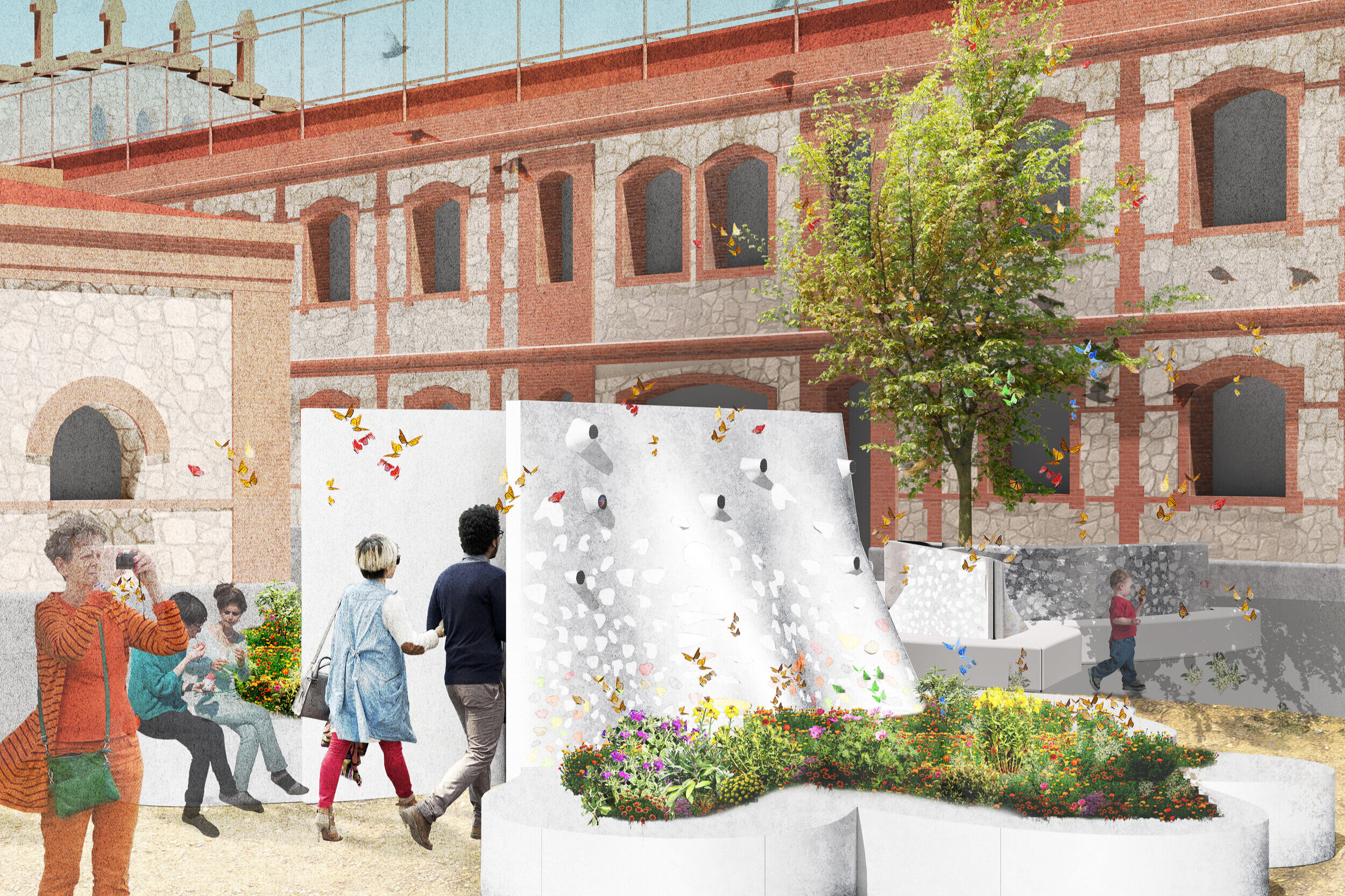Hidden in Plain Sight
by Nerea Feliz and Joyce Hwang
“Butterfly Vision”
Video Credits:
Visuals by Don Swaynos
Drone photography by Paul Toohey
Music by Curtis Heath
Hidden in Plain Sight is a proposal for a series of urban furnishings that aim to amplify and bring awareness to various forms of urban life and support an inclusive web of interdependent species, both human and non-human. This body of research is part of a multi-year initiative to design a collective “Cyborg Garden” to turn the outdoor spaces of the Matadero Madrid complex—a former slaughterhouse that has been converted to an arts center—into laboratories for testing nature-based solutions to make the complex more habitable in the face of global climate change. This initiative seeks to frame planetary change as a challenge that is as much cultural and political as it is scientific and technological. The design process included a series of monthly interdisciplinary workshops with representatives from Madrid City Council, as well as scientists and experts from various disciplines, including environmental engineering, botany, entomology, and pedology. Hidden in Plain Sight is one of five design proposals for a series of replicable prototypes designed to raise the resilience of this public space in Madrid. The project explores how design can amplify the current discourse on climate change in the context of public space.

HUMAN EXPERIENCE
Hidden in Plain Sight aims to enhance our experience of public space. It is conceived as a series of urban furnishing prototypes that bring shading, lighting, vegetation, and seating into the public sphere. This family of prototypes operates between and across scales, from the scale of humans to the scale of the insect. The series of urban rooms, walls, and furniture pieces can function as individual units or in aggregation. They set the stage for public programming, such as film screenings and small concerts. Borrowing from models of interior occupation—not streets but corridors, not squares but rooms—Hidden in Plain Sight introduces a sense of public interiority and cultivates urban intimacy between the environment and the life forms that inhabit it.
MULTI-SPECIES INHABITATION
The project seeks to make visible the underacknowledged world of non-human species, particularly insects, as active participants in urban life by attracting and magnifying their presence in our shared urban spaces. While we often think of cities as human-centered territory, insects are a significant part of our ecosystems, serving as pollinators, seed-dispersers, decomposers, and a food source for other species, such as bats and birds. Various insect species are also bioindicators, or “living barometers” of environmental conditions. According to a recent study, 40% of insect species are in danger of extinction in the coming decades due to climate change and the extensive use of pesticides. (1) To support and cultivate beneficial insect populations, the project team identified some of the most common butterfly and moth species in the Casa de Campo and Madrid Rio areas, where Matadero Madrid is sited. The Hidden in Plain Sight prototypes incorporate planting scenarios to accommodate both caterpillars and butterflies: mesh-enclosed planters protect caterpillars from predators, while open planting beds house brightly colored wildflowers to attract nectar-seeking butterflies.

MUTUALISM IN THE URBAN ENVIRONMENT
Hidden in Plain Sight deploys visual tactics to enhance insect habitability while also provoking human curiosity through new spatial and perceptual experiences. Stemming from the fascinating world of insect vision and perception, the project uses colors, patterns, and light to the benefit of both insects and humans. To provide a sense of camouflage for butterflies, patterns are imprinted on the prototypes’ curving walls; the patterns’ colors are coordinated with adjacent wildflowers. To promote habitability for birds, bats, bees, and other insects, distinct pods are fabricated and inserted into the upper portions of the prototype walls that add a textural and volumetric dimension to the prototypes’ undulating surfaces. At night, the design uses "positive phototaxis” and ultraviolet black light to attract insects, a phenomenon that can be video recorded and projected as a form of spectacle.
————
1. Sanchez-Bayo, Francisco & Wyckhuys, Kris A.G. "Worldwide decline of the entomofauna: a review of its drivers." Biological Conservation 232, (2019): 8-27.
Double Happiness is a collaboration between Nerea Feliz and Joyce Hwang. Their creative practice focuses on research and design at multiple scales with interests in the intersections of interior design, architecture, urbanism, and ecology. Collectively, they are registered architects in Spain, the UK, and New York State. Feliz is an Assistant Professor at the School of Architecture at the University of Texas at Austin, and directs Nerea Feliz Studio. Hwang is an Associate Professor and Associate Chair at the University at Buffalo, School
of Architecture and Planning, and directs Ants of the Prairie.
